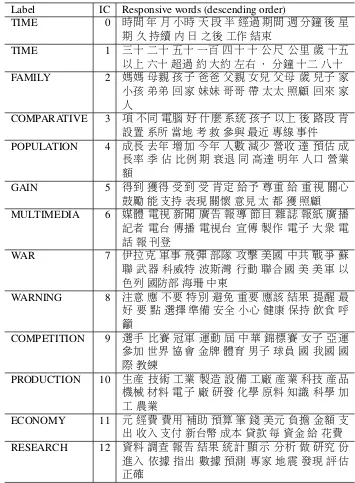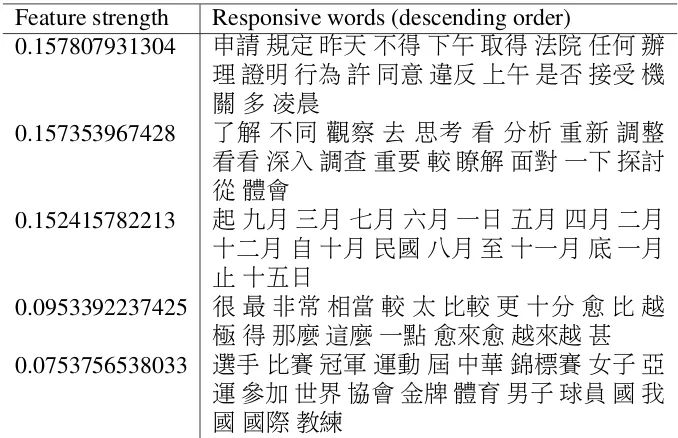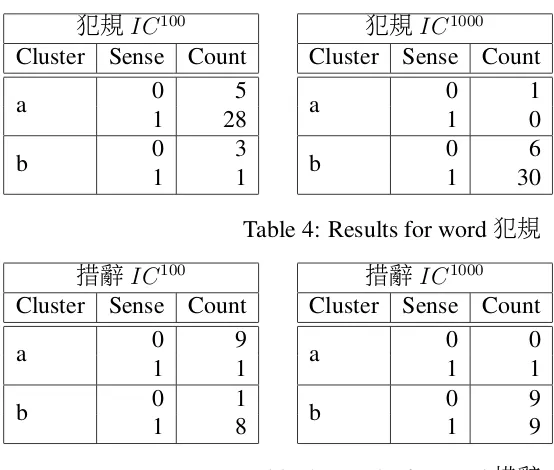Word sense induction using independent
component analysis
Petr ˇSimon
Institute of Linguistics
Academia Sinica, Taiwan
sim@klubko.net
Jia-Fei Hong
Graduate Institute of Linguistics
NTU, Taiwan
jiafei@gate.sinica.edu.tw
Abstract
This paper explores the possibilities of using independent component analysis (ICA) for features extraction that could be applied to word sense induction. Two different methods for using the features derived by ICA are introduced and results evaluated. Our goal in this paper is to observe whether ICA based feature vectors can be efficiently used for word context encoding and subsequently for clustering. We show that it is possible, further research is, however, necessary to ascertain more reliable results.
1
Introduction
Word senses are known to be difficult to discriminate and even though discrete definitions are usually sufficient for humans, they might pose problems for com-puter systems. Word sense induction is a task in which we don’t know the word sense as opposed to more popular word sense disambiguation.
Word sense can be analyzed by observing behaviour of words in text. In other words, syntagmatic and paradigmatic characteristics of a word give us enough information to describe all it’s senses, given that all it’s senses appear in the text.
strategies for creating the vectors that encode each word: global encoding strat-egy, which encodes co-occurrence of word types with other word types and local encoding strategy which encodes co-occurrence of word tokens with word types. The global encoding strategy is more popular, because it provides more informa-tion and does not suffer from data sparseness and most of the research has focused on sense analysis of words of different forms, i.e. on phenomena like synonymy etc. However, by encoding word types, we naturally merge all the possible sense distinctions hidden in word’s context, i.e. context of a token. For more details cf. (3; 11; 10).
Problem of high dimensionality that would be computationally restricting, us usually solved by one of several methods: principal component analysis (PCA), singular value decomposition (SVD) and random projection (RP) and latent se-mantic analysis, also known as latent sese-mantic indexing is a special application of dimensionality reduction where both SVD and PCA can be used. See (1; 2) for overview and critical analysis.
The classical approach to word context analysis is a vector space model, which uses simple the whole co-occurrence vectors when measuring word similarity. This approach also suffers from a problem similar to data sparseness, i.e. the sim-ilarity of words is based on word forms and therefore fails in case where synonym rather than similar word form is used in the vector encoding (11; 10).
Major problem with the classical simple vector space model approach is the superficial nature the information provided by mere co-occurrence frequency, which can only account for seen variables. One of the most popular approaches to word context analysis, latent semantic analysis (LSA), can improve this limitation, by creating a latent semantic space using SVD performed on word by document ma-trix. Frequency of occurrence of each word in a document represents each entry
wij in the matrix, thus, the whole document serves as a context. Document is,
naturally, some sort of meaningful portion of text. SVD then decomposes the original matrix into three matrices: word by concept matrix, concept by concept matrix and concept by document matrix. The results produced by LSA are, how-ever, difficult to understand for humans (9), i.e. there is no way of explaining their meaning.
2
ICA
analysis task.
ICA is capable of finding emergent linguistic knowledge without predefined categories as shown in (4; 5) and others.
As a method for feature extraction/dimensionality reduction it provides results that are approachable by humans reader. Major advantage of ICA is that it looks for factors that are statistically independent, therefore it is able find important representation for multivariate data.
ICA can be defined in a matrix form asx = As wheres = (s1, s2, ..., sn)T
represents the independent variables, components, and the original data is repre-sented byx = (x1, x2, ..., xn)T, which can be decomposed intos×A, whereA
is an×nsquare mixing-matrix.
Both the mixing-matrixAand independent componentssare learning by un-supervised process from the observed data x. For more rigorous explanation see (7).
We have used FastICA algorithm as implemented in R language1.
3
Data collection
The context matrix has been constructed from words from Sinica Corpus of a frequency higher than 150. This restriction yielded 5969 word types. We have chosen this limited lexicon to lower the complexity of the task.
The whole corpus was stripped from everything but all words whose word class tag started with N, V, A or D. This means that our data consisted of nouns (N, including pronouns), verbs (V), adjectives (A) and adverbs (D)2.
Then we collected co-occurrence statistics for all words from window of 4 preceding and 4 following words, but only if these were within a sentence. We defined sentence simply as a string of words delimited by ideographic full-stop, comma, exclamation and question mark (。,,,! and ?). In case of context being shorter than 4 words, the remaining slots were substituted by zero indicating no data available.
We have normalized the data by taking log of each data pointaij in context
matrix. Since this is a sparse matrix and lot of data points are zero, one has been added to each data point.
After the extraction of the independent components, we have encoded contexts of word tokens for each word type selected for analysis using these independent components. Thus we are able to provide reliable encoding for words, which is based on global properties. Note that there is no need to pursue orthogonality of different word types that are sometimes required in the context encoding. The
1http://www.stats.ox.ac.uk/ marchini/software.html
similarities between different word types are based on the strength of independent components for each word type and therefore much better results of similarity measure can be expected than one would get from binary random encoding as introduced in (8).
We could experiment with several strategies to context matrix construction: different word classes in the context and different sizes of feature vectors. Con-text in our experiments is defined by four words that precede and four words that follow each keyword. Then we study the feature similarities across different words. To aid the analysis, a hierarchical clustering is used to determine closeness of relation among feature vectors of specified dimension. This step is to find most reliable feature vector dimension for subsequent experiments. As mentioned be-fore, the features can be traced back and their nature determined, i.e. they can be labelled.
Due to the time constraints, we have predetermined feature vector size before-hand. We’ve extracted 100 and 1000 independent components and used them in two separate experiments.
Having determined the size of feature vectors, we use original word contexts for each word token and encode the context using these vectors. That means that each word in the context of particular keyword is replaced by it’s respective feature vector, a vector of quantified relations to each of the independent components that has been extracted by ICA from the global co-occurrence matrix.
We than use maximum-linkage hierarchical clustering to find related words and based on the features present in the vectors we determine their characteristics that will provide clues to their word senses.
4
Results
We ran two experiments, one with 100 independent components and the second with 1000 components. For the experiment we have manually selected 9 words, which we expected to be easier to analyze. We have, however, failed to find in Chinese word that would allow for such obvious sense distinctions as English
plant,palm, bank etc. Such words are typically used in word sense related task to test the new algorithms. The failure to find words that would have similarly clear-cut sense distinctions, might have influenced our initial results. The words we have selected are (number in bracket indicates the number of senses according to Chinese Wordnet)3: 山頭(3),名牌(2),犯規(2),約談(2),措辭(2),堅硬(2),富 有(2),屬下(2),天氣(3).
4.1
Independent components
When ICA algorithm retrieves the specified number of independent components, each of them can be labelled by creating a descending list of those words that are most responsive for each of the components (5; 4). Only the most responsive word could be assigned to each of the components as a label, but this way we would not be able to determine characteristics of the components with sufficient clarity. As we will see, even listing several items from the top of the list of the most respon-sive words, won’t always provide clear explanation of the nature of the component in question. This is due to the fact that the independent components are not yet very well understood, that it is not yet entirely obvious how the components are created (5).
Bellow are few examples independent components and labels assigned to each of them. We list up to 20 most responsive words for each component to provide information for human judgment. These are examples from the 100 independent components experiment. For future research, perhaps an automatic way of deter-mining different number of labels required to explain each independent compo-nent might be proposed using time series analysis, but for that, more research has to be provided to better understand the nature of independent components in order to justify such step.
First ten independent components can be seen in 1. As we can see, indepen-dent components cannot we regarded as synsets as known in WordNet, since they clearly contain words from multiple classes. We can perhaps call them colloca-tion sets, colsets. But this term will have to be revised based on the subsequent research on the nature of independent components.
Table 4.1 shows an example how a particular word type is encoded. The inde-pendent components in this example are are sorted by the most important features. We can see how the encoding in Table 4.1 contrasts with Table 4.1, which shows ten least salient features for word typeyuyan語言.
4.2
Sense clustering
We have used maximum-linkage hierarchical algorithm from Pycluster package4
to cluster word token contexts. The use of hierarchical clustering is motivated by the attempt to provide gradual sense analysis where subsenses could be identified within partial senses.
Our goal in this paper is to observe whether ICA based feature vectors can be efficiently used for word context encoding and subsequently for clustering. Clustering results were evaluated by native speaker with linguistics knowledge, who labelled all the sentences according to Chinese Wordnet and in this paper,
Label IC Responsive words (descending order)
TIME 0 時間年月小時天段半經過期間週分鐘後星 期久持續內日之後工作結束
TIME 1 三十二十五十一百四十 十公尺 公里歲十五 以上六十超過約大約左右.分鐘十二八十
FAMILY 2 媽媽母親孩子爸爸 父親女兒父母 歲兒子 家
小孩弟弟回家妹妹哥哥帶太太照顧回來家 人
COMPARATIVE 3 項不同電腦好什麼系統孩子以上後路段肯
設置系所當地考救參與最近專線事件
POPULATION 4 成長去年增加今年 人數減少營收達預估成
長率季佔比例期衰退同高達明年人口營業 額
GAIN 5 得到獲得受到受肯定給予尊重給重視關心
鼓勵能支持表現關懷 意見太都獲照顧
MULTIMEDIA 6 媒體 電視 新聞廣告 報導節目雜誌 報紙廣播 記者 電台 傳播電視台 宣傳製作電子 大眾電
話報刊登
WAR 7 伊拉克軍事 飛彈部隊 攻擊美國中共 戰爭蘇 聯 武器科威特波斯灣 行動聯合國美 美軍以 色列國防部海珊中東
WARNING 8 注意 應不要特別避免重要應該結果提醒最
好要點選擇準備安全小心健康保持飲食呼 籲
COMPETITION 9 選手 比賽 冠軍運動 屆中華錦標賽 女子亞運
參加世界協會金牌 體育男子球員國我國 國 際教練
PRODUCTION 10 生產 技術 工業製造 設備工廠產業 科技產品
機械材料電子廠研發化學原料知識科學加 工農業
ECONOMY 11 元經費 費用補助預算 筆錢美元負擔金額支 出收入支付新台幣成本貸款 每資金給花費
RESEARCH 12 資料調查報告結果統計顯示 分析做研究份 進入依據 指出數據預測 專家地震 發現評估 正確
Feature strength Responsive words (descending order)
7.55055952072 用字聽語言首英文句唱音樂詞表達歌 心國語獲得寫聲音使用詩歌曲
6.93665552139 特色具有具原住民特殊文化獨特語言風
格色彩豐富背景不同特性表現很多當地 傳統歷史最
6.20834875107 教學英語國小國中教育學習老師課程教
師小學高中學校孩子小朋友學生家長教 材數學教科書英文
3.42819428444 她得我他快孩子玩吃深態度全起來父
親父母跑家庭母親共同相當一起
3.34706568718 品質提高 高提升水準成本降低效率達到
低提昇改善安全整體保障服務過國民享 受考量
Table 2: Partial example of encoded word語言(five most salient features)
Feature strength Responsive words (descending order)
0.157807931304 申請規定昨天不得下午 取得法院任何辦
理證明行為許同意違反上午是否接受機 關多凌晨
0.157353967428 了解 不同 觀察 去思考 看 分析重新 調整
看看深入調查重要較瞭解面對一下探討 從體會
0.152415782213 起九月三月七月六月一日五月四月二月
十二月自十月民國八月至十一月底一月 止十五日
0.0953392237425 很最非常相當較太比較更十分愈比越
極得那麼這麼一點愈來愈越來越甚
0.0753756538033 選手比賽冠軍運動屆中華錦標賽女子亞
運參加世界協會金牌體育男子球員國我 國 國際教練
山頭IC100
Cluster Sense Count
a
0 39 1 21 2 11
b
0 7
1 10
2 0
c
0 2
1 1
2 0
山頭IC1000
Cluster Sense Count
a
0 32 1 39
2 9
b
0 0
1 3
2 0
c
0 5
1 2
2 1
Table 7: Results for word措辭
Word IC100 IC1000
山頭 0 0 名牌 0 0
犯規 1 1
約談 0 1
措辭 1 1
堅硬 0 1
富有 0 0
屬下 0 1 天氣 0 0
5
Conclusion
The major advantage of our approach is that it uses global characteristics of words based on their co-occurrence with other words in the language, which are then applied to derive local encoding of word context. Thus we retrieve reliable char-acteristics of word’s behaviour in the language and don’t loose the word sense information, which allows us to analyze semantic characteristics of similar word forms.
Our current results are not very satisfying. I can be observed, however, from Table8 that increased number improves the sense induction considerably. We will pursue this track in our subsequent research. On the other hand, this result is not surprising. Considering the nature of independent components, which are rather symbolic features similar to synonymic sets, synsets, or rather collocation sets, collsets, it can be expected that much larger number of these components would be required to encode semantic information.
6
Future work
With manually semantically tagged word tokens we will try to automatically esti-mate the sufficient number of independent components that would improve preci-sion of sense clustering.
Another approach we intend to try is to add feature vectors of all the context words and cluster the resulting vectors. This approach should emphasize more important features in given contexts.
We will also do more carefull preprocessing and also apply dimensionality reduction (typically done by PCA) before running ICA as has been done in some of the previous studies.
References
evaluation. In11 th Conference of the European Chapter of the Association for Computational Linguistics: EACL 2006, pages 137–144, 2006.
[4] T. Honkela and A. Hyv¨arinen. Linguistic feature extraction using indepen-dent component analysis. InProc. of IJCNN 2004, 2004.
[5] T. Honkela, A. Hyv¨arinen, and J. V¨ayrynen. Emergence of linguistic fea-tures: Independent component analysis of context. In A. C. et al., editor,
Proceedings of NCPW9, 2005.
[6] A. Hyv¨arinen, J. Karhunen, and E. Oja. Independent component analysis. Wiley, 2001.
[7] A. Hyv¨arinen and E. Oja. Independent component analysis: Algorithms and applications. Neural networks, 13(4):411–430, 2001.
[8] S. Kaski. Dimensionality reduction by random mapping: Fast similarity computation for clustering. InProceedings of IJCNN’98, International Joint Conference on Neural Networks, volume 1, pages 413–418. IEEE Service Center, Piscataway, NJ, 1998.
[9] T. Landauer and S. Dumais. A solution to plato’s problem: The latent seman-tic analysis theory of acquisition, induction, and representation of knowl-edge. Psychological Review, 104(2):211–240, 2001.
[10] D. B. Neill. Fully automatic word sense induction by semantic clustering. Master’s thesis, Cambridge University, 2002.
[11] R. Rapp. A practical solution to the problem of automatic word sense in-duction. In The Companion Volume to the Proceedings of 42st Annual Meeting of the Association for Computational Linguistics, pages 194–197, Barcelona, Spain, July 2004. Association for Computational Linguistics. [12] J. V¨ayrynen and T. Honkela. Comparison of independent component



